Archives
You are currently viewing archive for April 2011
|
April 15, 2011 08:37:39
Posted By DelvecchioRC
|
|
|
|
April 14, 2011 09:13:25
Posted By DelvecchioRC
|
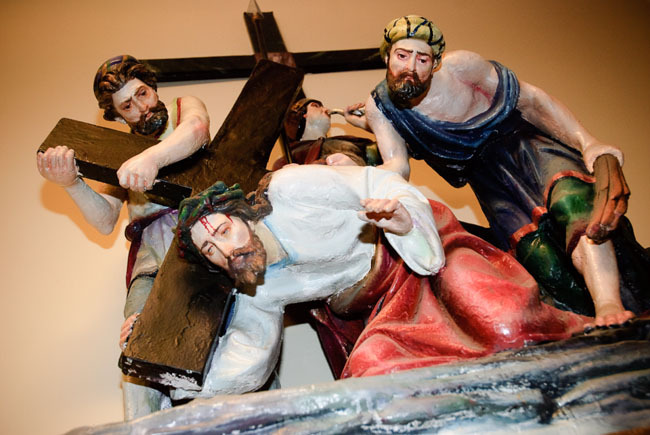
The Stations of the Cross originated in pilgrimages to Jerusalem. A desire to reproduce the holy places in other lands seems to have manifested itself at quite an early date. At the monastery of Santo Stefano at Bologna a group of connected chapels was constructed as early as the 5th century, by St. Petronius, Bishop of Bologna, which was intended to represent the more important shrines of Jerusalem, and in consequence, this monastery became familiarly known as "Hierusalem.” These may perhaps be regarded as the germ from which the Stations afterwards developed, though it is tolerably certain that nothing that we have before about the 15th century can strictly be called a Way of the Cross in the modern sense. Although several travelers who visited the Holy Land during the twelfth, thirteenth, and 14th centuries (e.g. Riccoldo da Monte di Croce, Burchard of Mount Sion, James of Verona), mention a "Via Sacra,” i.e., a settled route along which pilgrims were conducted, there is nothing in their accounts to identify this with the Way of the Cross, as we understand it. The devotion of the Via Dolorosa, for which there have been a number of variant routes in Jerusalem, was probably developed by the Franciscans after they were granted administration of the Christian holy places in Jerusalem in 1342. The earliest use of the word “stations,” as applied to the accustomed halting-places in the Via Sacra at Jerusalem, occurs in the narrative of an English pilgrim, William Wey, who visited the Holy Land in the mid-15th century, and described pilgrims following the footsteps of Christ to the cross. In 1521 a book called Geystlich Strass was printed with illustrations of the stations in the Holy Land. During the 15th and 16th centuries the Franciscans began to build a series of outdoor shrines in Europe to duplicate their counterparts in the Holy Land. The number of stations varied between eleven and thirty. In 1686, in answer to their petition, Pope Innocent XI granted to the Franciscans the right to erect stations within their churches. In 1731, Pope Clement XII extended to all churches the right to have the stations, provided that a Franciscan father erected them, with the consent of the local bishop. At the same time the number was fixed at fourteen. In 1857, the bishops of England were allowed to erect the stations by themselves, without the intervention of a Franciscan priest, and in 1862 this right was extended to bishops throughout the church.
In the Roman Catholic Church, Pope John Paul II led an annual public prayer of the Stations of the Cross at the Roman Colosseum on Good Friday. Originally, the Pope himself carried the cross from station to station, but in his last years when age and infirmity limited his strength, John Paul presided over the celebration from a stage on the Palatine Hill, while others carried the cross. Just days prior to his death in 2005, Pope John Paul II observed the Stations of the Cross from his private chapel. Each year a different person is invited to write the meditation texts for the Stations. Past composers of the Papal Stations include several non-Catholics. The Pope himself wrote the texts for the Great Jubilee in 2000 and used the traditional Stations.The celebration of the Stations of the Cross is especially common on the Fridays of Lent, especially Good Friday. Community celebrations are usually accompanied by various songs and prayers. Particularly common as musical accompaniment is the Stabat Mater. At the end of each station the Adoramus Te is sometimes sung. The Alleluia is also sung, except during Lent.
|
|
April 13, 2011 09:27:56
Posted By DelvecchioRC
|
Gently tear or snap off a palm blade off the palm stalk. The type of palm doesn't matter provided it bends easily; just test its give before snipping and keep testing until you find blades that are adequately flexible.
Hold the palm blade pointy side up.
Fold the blade to the right to make a 90 degree angle.
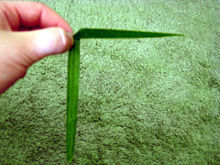
Fold down once. Then, fold down again. You should now have a small square shape.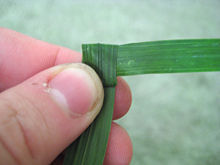
Push the pointy end around the back of the square and fold over.
Take the pointy end on the left, and loop it towards you without making any turns. Then: Push then pull the pointy end through the square until it comes out of the square. 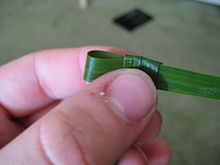
Pull through all the way.
Hold onto the square with one hand and tug on the fat and pointed ends to secure it. You should now have a locked 90 degree angle.
Take the pointy end and turning it towards yourself, push through the square. This is the head and base of the cross.
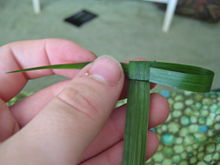
Turn 45 degrees to where the pointy end is facing downward and the fat end is facing to your right.
Flip it so that the fat end is now on your left.
Take the fat end and loop it towards you into the square. Pull it until it reaches about the same length as the head.
Turn it over to where the straight fat end faces left again.
Take the fat end and loop it towards you back into the square. Pull until it is about the same length as the other two parts. Be sure to tuck it inside the other loop so that you can't see it. You're done!
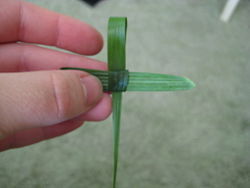
|
|
April 12, 2011 12:27:59
Posted By DelvecchioRC
|
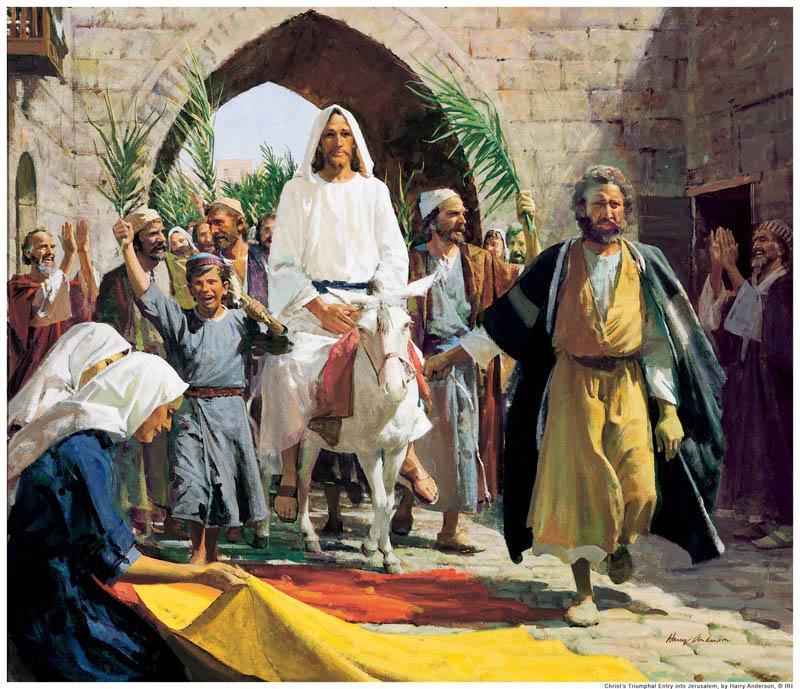
Palm Sunday (first known as Pasha) originated in the Jerusalem Church around the late third or early fourth century. Ceremonies consisted of prayers, hymns, and sermons as people moved through the numerous holy sites within the city. At the last site, the place of Jesus’ ascension into heaven, the clergy would read the biblical account of Jesus’ Triumphal Entry into Jerusalem. Then as evening approached, the people would return to the city reciting: “Blessed is He that comes in the name of the Lord” (Matthew 21:9). By the fifth century, the celebration had spread as far as Constantinople. It wasn’t until the sixth and seventh centuries that the ritual blessing of the palms was added. A morning procession replaced the evening one and by the eighth century, the Western Church was celebrating “Dominica in Palmis” or “Palm Sunday.”
Palm Sunday - The Tradition
Palm Sunday is also known as Passion Sunday in recognition of the beginning of Holy Week and Jesus’ final agonizing journey to His crucifixion. Falling on the sixth Sunday in Lent and the Sunday before Easter, Palm Sunday is celebrated in all major Christian churches—Roman Catholic, Protestant, and Orthodox. In many Orthodox churches, Palm Sunday is known as Entry into Jerusalem. In some countries, the graves of loved ones are decorated with palms. Since palm trees are not indigenous to colder climates, branches of sallow, willow, and yew are often used.
Today, many Palm Sunday traditions remain much the same as those celebrated in the tenth century. Some ceremonies begin with the blessing of the palms. Afterward, many people take the palms home and place them in houses, barns, and fields. In many churches, children serve as an integral part of the service since they enjoy the processions. Children often craft crosses from palm leaves which were used in the Sunday processional. The traditions of Palm Sunday serve as reminders of the life-changing events of Holy Week.
Palm Sunday - The History
|
|
April 11, 2011 12:19:54
Posted By DelvecchioRC
|
St. Lazarus
was born in Bethany, a small town near Jerusalem. Jesus knew his father Simon and used to visit their home every time he was in the area. He developed so a close friendship with Lazarus, who followed his teaching and ideals.
At the age of thirty Lazarus became very ill. His sisters Martha and Maria informed Jesus of the seriousness of his condition but he did not seem to be concerned. By the time Jesus arrived at Bethany, Lazarus was dead and buried for four days. Jesus went straight to his grave, he prayed and then raised his voice: "Lazarus, come out", he shouted. And indeed, in a while Lazarus came out of the grave wrapped with his burial cloth. He was un-wrapped and returned with Jesus to his house, accompanied by the crowd. Following this miracle even more people believed in Christ and followed his teachings. This was the reason why the leaders of the Jews decided to assassinate him. When Lazarus learnt about their plans he found refused at Kition (Larnaca) of Cyprus. There he was met by the apostles Paul and Barnabas, who ordained him as the first bishop of Kition. Lazarus became an example of a Christian. His physical presence was an indication of God's love for his people while his spiritual activity symbolized the love of man for God.
Lazarus died at the age of sixty and was buried in a sarcophagus at Kition with an inscription "The four-day Lazarus, friend of Christ". In 890 AD the emperor of Byzantium Leon VI Sophos transferred Lazarus' remains to Constantinople and in return he built a church at Larnaca devoted to St. Lazarus. The church survives to this date.
In the Catholic tradition all saints are depicted in statues and Saint Lazarus is no different. The statue for Saint Lazarus is usually depicted as a poor man in crutches with dogs around him. His clothing will be minimal and usually in the color purple. Saint Lazarus Feast Day or the day of observation for Saint Lazarus is December 17th. Both od Saint Lazarus sisters are recognized as saints in their own right. Saint Martha is considered the patron Saint of Servants and Cooks. The day of observance or Feast Day for Saint Martha is July 29th. Saint Mary's feast Day or Day of Observance is July 22nd.
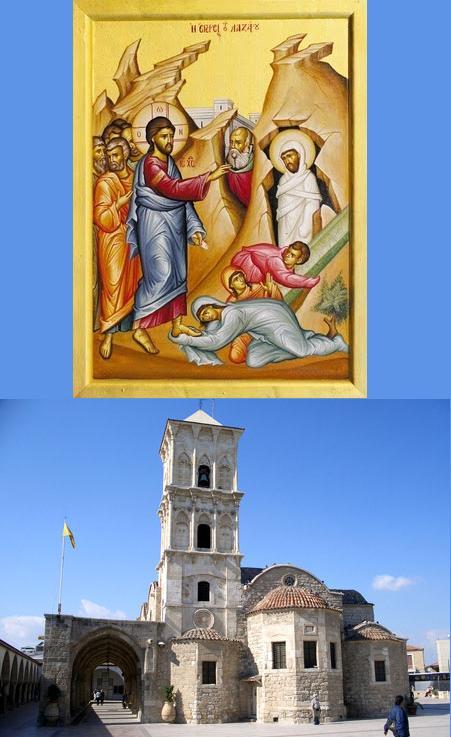
|
|
|
|